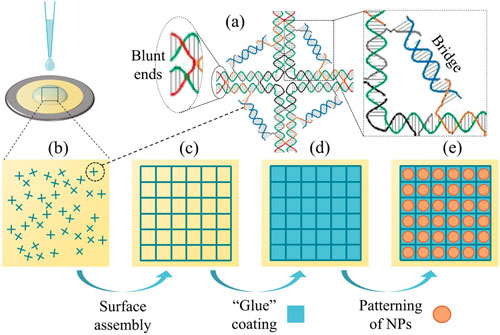| Feb 27, 2019 | |
Using DNA molds for templating nanoparticles into 2D patterns |
|
| (Nanowerk Spotlight) Architecture is key when designing new materials – and DNA is probably the most programmable biomaterial for creating a wide range of rationally designed and functionally enhanced nanostructures. | |
| DNA nanotechnology employs DNA as a programmable building material for self-assembled, nanoscale structures with precisely controlled features, that can lead to improved surface properties relevant to biosensing, materials science, and cell biology. | |
| Adding to the available tools for DNA nanopatterning, researchers at Purdue University have demonstrated a novel biotemplating strategy for ordering various nanoparticles into expected two-dimensional (2D) patterns via nanoparticle-surface or nanoparticle-DNA interaction. They reported their findings in ACS Applied Materials & Interfaces ("Patterning Nanoparticles with DNA Molds"). | |
 |
|
| Process of nanoparticle (NP) patterning directed by DNA arrays. (a) Molecular design of bridged 4-point-star (b4PS) motifs. (b) When DNA solution (light blue) contacts a mica surface (yellow), b4PS motifs (blue) will randomly adsorb onto mica surface. (c) Driven by base stacking between blunt ends, b4PS motifs rearrange themselves on the solid surface into 2D arrays. (d) The mica surface is then coated by “glues”, which are positively charged materials (poly-L-lysine or Ni2+). They are used to trap negatively charged NPs. (e) Patterning NPs (red) by DNA arrays. (Reprinted with permission by American Chemical Society) | |
| "We have developed a general and robust templating approach by DNA molds for patterning various nanomaterials, including inorganic nanoparticles and biomolecules," Prof. Chengde Mao, who led the work, explains to Nanowerk. "The DNA molds are large, homogeneous, 2D arrays, whose tiling types are controlled by individually designed DNA motifs. The non-specific surface adsorption makes this approach a general strategy to pattern a large variety of nanomaterials." | |
| The team's approach achieved much denser patterning (∼1200-2000 cavities per µm2) compared with previously reported DNA origami approaches (∼100 cavities per µm2). | |
| Meanwhile, these DNA molds are much larger and more uniform because the surface-based DNA assembly can be effectively controlled by DNA-surface interaction. | |
| The method uses nonspecific surface adsorption to pattern nanoparticles. This is different from previous approaches through extra hybridization on DNA templates, which requires specific nanoparticle modifications. Such an approach is simpler, more general, and more robust. | |
| As demonstrated in this work, patterned nanoparticles do not require extra modifications, which simplifies the preparation process and conserves their functionality. This results in a wider range of nanoparticles available as candidate materials for nanopatterning. | |
| Mao notes that the ordered nanoparticle patterns have potential applications in, among other areas, biosensing. For example, gold nanoparticle patterns can serve as substrates for surface-enhanced Raman spectroscopy (SERS) detections. Protein patterning is promising in studying biosensor systems and protein-protein, protein-cell interactions. | |
| Going forward, the researchers will explore making DNA molds work for surfaces other than mica and investigate designing molds of high complexity to achieve different patterns and to control the orientations of patterned nanomaterials. | |
| "We are also eager to pattern many other functional nanoparticles, including semiconductors for energy applications, and functional enzymes for creating 2D enzymatic cascades with highly efficient catalysis," says Mao. | |
| Another goal is to generalize the strategy in order to pattern various nanomaterials via nonspecific interaction such as electrostatic surface adsorption. | |
| "By modifying positively-charged 'glues' on a surface, any negatively-charged nanomaterial can be patterned when their size fits the cavity of DNA molds," Mao notes. | |
| "Although DNA self-assembly is well studied, its potential applications in other fields are still being explored," he concludes. "It is promising to use DNA nanostructures as templates to organize other materials. How the materials are patterned depends on how DNA nanostructures are designed, which makes this form of nanopatterning much easier than others due to the excellent programmability of DNA nanotechnology." | |
 By
Michael
Berger
– Michael is author of three books by the Royal Society of Chemistry:
Nano-Society: Pushing the Boundaries of Technology,
Nanotechnology: The Future is Tiny, and
Nanoengineering: The Skills and Tools Making Technology Invisible
Copyright ©
Nanowerk LLC
By
Michael
Berger
– Michael is author of three books by the Royal Society of Chemistry:
Nano-Society: Pushing the Boundaries of Technology,
Nanotechnology: The Future is Tiny, and
Nanoengineering: The Skills and Tools Making Technology Invisible
Copyright ©
Nanowerk LLC
|
|
|
Become a Spotlight guest author! Join our large and growing group of guest contributors. Have you just published a scientific paper or have other exciting developments to share with the nanotechnology community? Here is how to publish on nanowerk.com. |
|
